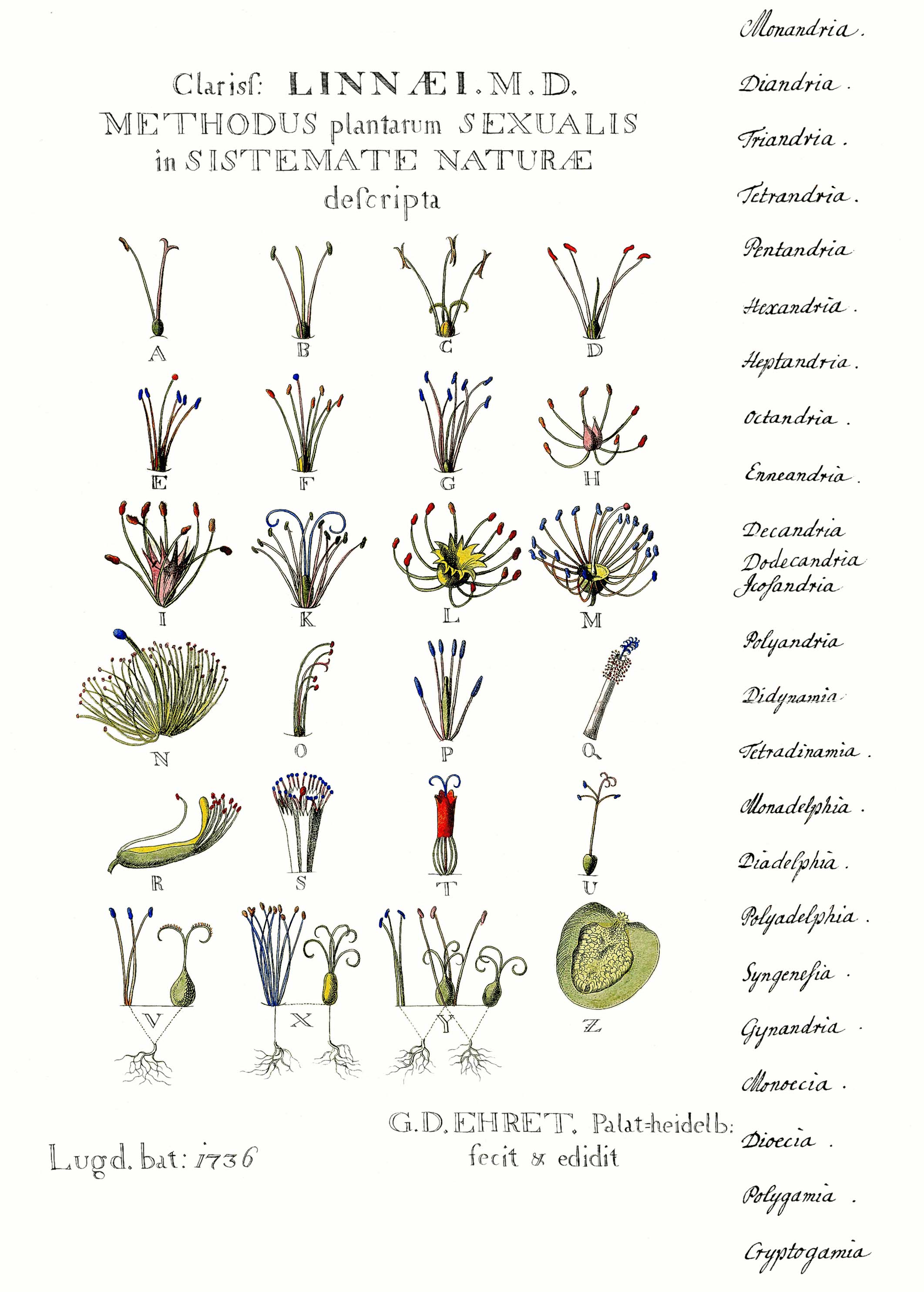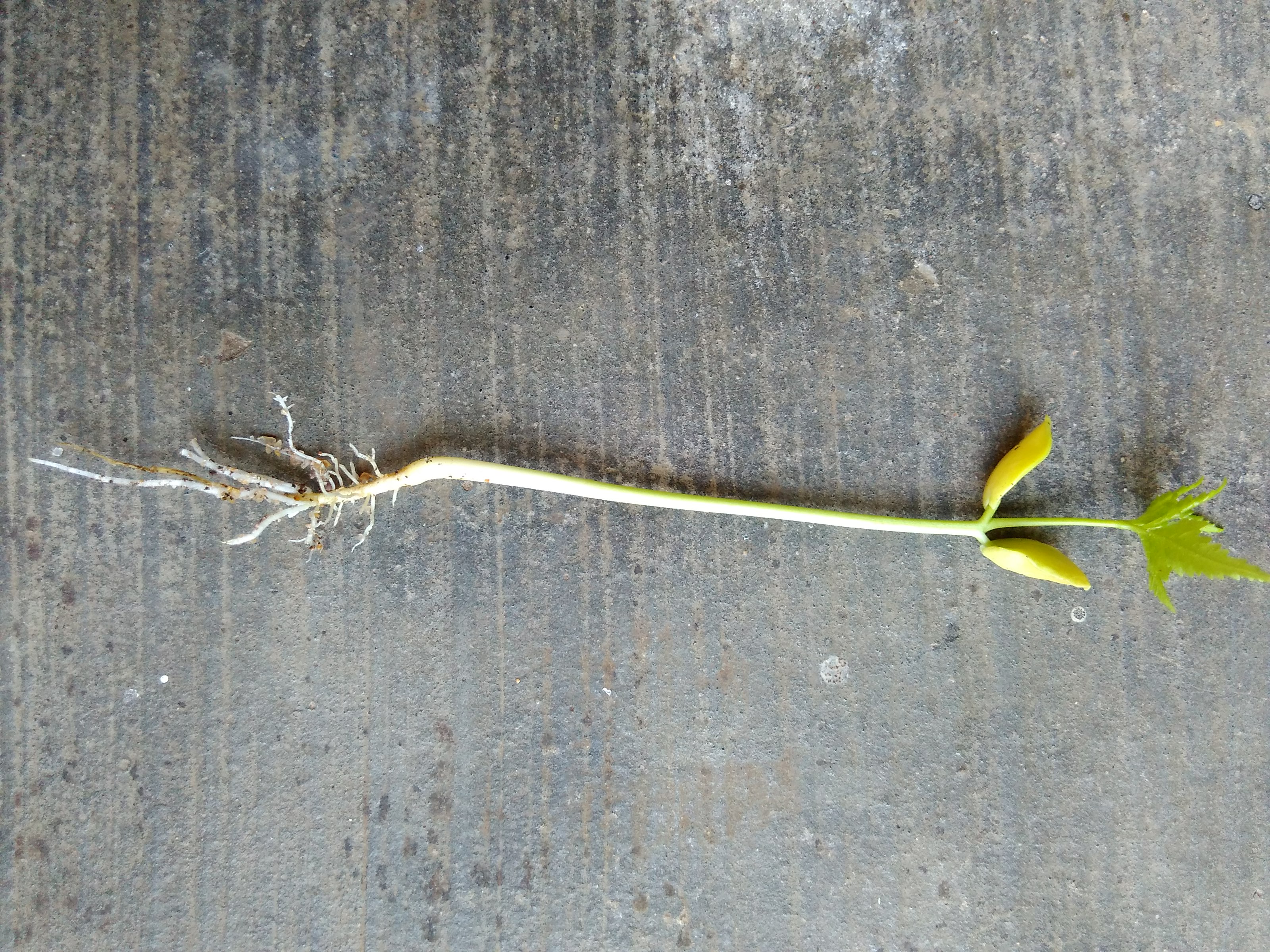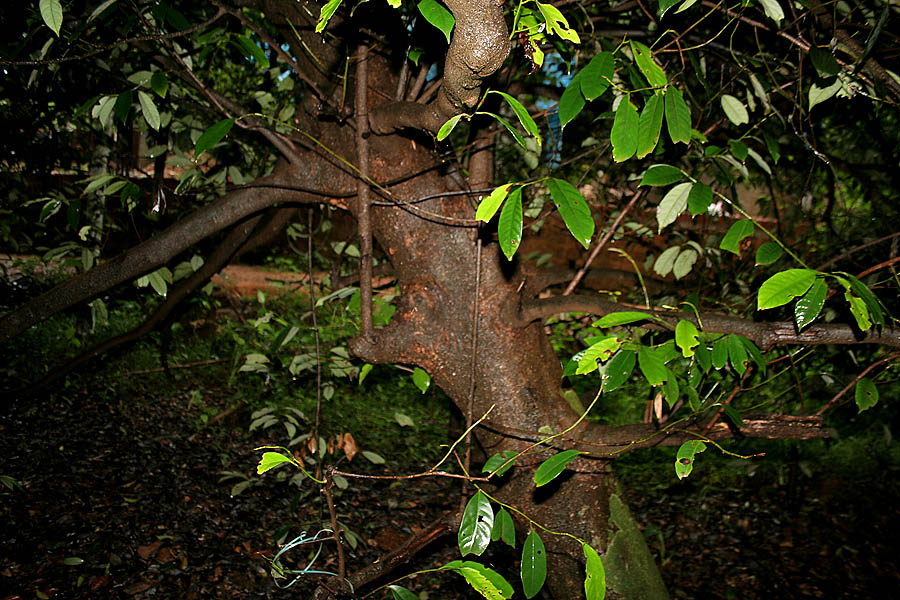|
Austrobaileya
''Austrobaileya'' is the sole genus in the plant family Austrobaileyaceae – the family is thus 'monotypic' as it includes a single child taxon. It is one of the basal angiosperm families, the most ancient group of flowering plants. The genus is also monotypic, containing the single species ''Austrobaileya scandens''. The species is endemic to the Wet Tropics bioregion of Queensland, Australia, where it occurs in well-developed upland rainforest. It was first described in 1933. Description ''Austrobaileya'' plants grow as woody lianas or vines. Their main growing stems loosely twine, with straight, extending, leafy branches. The leaves are leathery, veined and simple. The leaves produce essential oils in spherical ethereal oil cells. Their foliage is damaged by oxidation in direct sunlight, so it tends to grow beneath the rainforest canopy, in low-sunlight and very humid conditions. Like many other flowering plants growing in the understory of tropical rainforest, it does n ... [...More Info...] [...Related Items...] OR: [Wikipedia] [Google] [Baidu] |
Austrobaileyales
Austrobaileyales is an order of flowering plants consisting of about 100 species of woody plants growing as trees, shrubs and lianas. A well known example is '' Illicium verum'', commonly known as star anise. The order belongs to the group of basal angiosperms, the ANA grade (Amborellales, Nymphaeales, and Austrobaileyales), which diverged earlier from the remaining flowering plants. Austrobaileyales is sister to all remaining extant angiosperms outside the ANA grade.Insights into the dynamics of genome size and chromosome evolution in the early diverging angiosperm lineage Nymphaeales (water lilies), Jaume Pellicer, Laura J Kelly, Carlos Magdalena, Ilia Leitch, 2013, Genome, 10.1139/gen-2013-0039 The order includes just three families of flowering plants: the Austrobaileyaceae, a monotypic family containing the sole genus, '' Austrobaileya scandens'', a woody liana; the Schisandraceae, a family of trees, shrubs, or lianas containing essential oils; and the Trimeniaceae, esse ... [...More Info...] [...Related Items...] OR: [Wikipedia] [Google] [Baidu] |
Basal Angiosperm
The basal angiosperms are the flowering plants which diverged from the lineage leading to most flowering plants. In particular, the most basal angiosperms were called the ANITA grade, which is made up of ''Amborella'' (a single species of shrub from New Caledonia), Nymphaeales (water lilies, together with some other aquatic plants) and Austrobaileyales (woody aromatic plants including star anise). ''ANITA'' stands for ''Amborella'', ''N''ymphaeales, ''I'' lliciales, ''T''rimeniaceae, and '' Austrobaileya''. Some authors have shortened this to ''ANA''-grade for the three orders, ''A''mborellales, ''N''ymphaeales, and ''A''ustrobaileyales, since the order Iliciales was reduced to the family Illiciaceae and placed, along with the family Trimeniaceae, within the Austrobaileyales. The basal angiosperms are only a few hundred species, compared with hundreds of thousands of species of eudicots, monocots, and magnoliids. They diverged from the ancestral angiosperm lineage before ... [...More Info...] [...Related Items...] OR: [Wikipedia] [Google] [Baidu] |
Magnoliophyta
Flowering plants are plants that bear flowers and fruits, and form the clade Angiospermae (). The term angiosperm is derived from the Greek words (; 'container, vessel') and (; 'seed'), meaning that the seeds are enclosed within a fruit. The group was formerly called Magnoliophyta. Angiosperms are by far the most diverse group of land plants with 64 orders, 416 families, approximately 13,000 known genera and 300,000 known species. They include all forbs (flowering plants without a woody stem), grasses and grass-like plants, a vast majority of broad-leaved trees, shrubs and vines, and most aquatic plants. Angiosperms are distinguished from the other major seed plant clade, the gymnosperms, by having flowers, xylem consisting of vessel elements instead of tracheids, endosperm within their seeds, and fruits that completely envelop the seeds. The ancestors of flowering plants diverged from the common ancestor of all living gymnosperms before the end of the Carboniferous, o ... [...More Info...] [...Related Items...] OR: [Wikipedia] [Google] [Baidu] |
Angiosperms
Flowering plants are plants that bear flowers and fruits, and form the clade Angiospermae (). The term angiosperm is derived from the Greek words (; 'container, vessel') and (; 'seed'), meaning that the seeds are enclosed within a fruit. The group was formerly called Magnoliophyta. Angiosperms are by far the most diverse group of land plants with 64 orders, 416 families, approximately 13,000 known genera and 300,000 known species. They include all forbs (flowering plants without a woody stem), grasses and grass-like plants, a vast majority of broad-leaved trees, shrubs and vines, and most aquatic plants. Angiosperms are distinguished from the other major seed plant clade, the gymnosperms, by having flowers, xylem consisting of vessel elements instead of tracheids, endosperm within their seeds, and fruits that completely envelop the seeds. The ancestors of flowering plants diverged from the common ancestor of all living gymnosperms before the end of the Carbonifero ... [...More Info...] [...Related Items...] OR: [Wikipedia] [Google] [Baidu] |
Flowering Plant
Flowering plants are plants that bear flowers and fruits, and form the clade Angiospermae (). The term angiosperm is derived from the Ancient Greek, Greek words (; 'container, vessel') and (; 'seed'), meaning that the seeds are enclosed within a fruit. The group was formerly called Magnoliophyta. Angiosperms are by far the most diverse group of Embryophyte, land plants with 64 Order (biology), orders, 416 Family (biology), families, approximately 13,000 known Genus, genera and 300,000 known species. They include all forbs (flowering plants without a woody Plant stem, stem), grasses and grass-like plants, a vast majority of broad-leaved trees, shrubs and vines, and most aquatic plants. Angiosperms are distinguished from the other major seed plant clade, the gymnosperms, by having flowers, xylem consisting of vessel elements instead of tracheids, endosperm within their seeds, and fruits that completely envelop the seeds. The ancestors of flowering plants diverged from the commo ... [...More Info...] [...Related Items...] OR: [Wikipedia] [Google] [Baidu] |
APG III System
The APG III system of flowering plant classification is the third version of a modern, mostly molecular-based, system of plant taxonomy being developed by the Angiosperm Phylogeny Group (APG). Published in 2009, it was superseded in 2016 by a further revision, the APG IV system. Along with the publication outlining the new system, there were two accompanying publications in the same issue of the Botanical Journal of the Linnean Society: * The first, by Chase & Reveal, was a formal phylogenetic classification of all land plants (embryophytes), compatible with the APG III classification. As the APG have chosen to eschew ranks above order, this paper was meant to fit the system into the existing Linnaean hierarchy for those that prefer such a classification. The result was that all land plants were placed in the class Equisetopsida, which was then divided into 16 subclasses and a multitude of superorders. * The second, by Haston ''et al.'', was a linear sequence of families fol ... [...More Info...] [...Related Items...] OR: [Wikipedia] [Google] [Baidu] |
Dicotyledons
The dicotyledons, also known as dicots (or, more rarely, dicotyls), are one of the two groups into which all the flowering plants (angiosperms) were formerly divided. The name refers to one of the typical characteristics of the group: namely, that the seed has two embryonic leaves or cotyledons. There are around 200,000 species within this group. The other group of flowering plants were called monocotyledons (or monocots), typically each having one cotyledon. Historically, these two groups formed the two divisions of the flowering plants. Largely from the 1990s onwards, molecular phylogenetic research confirmed what had already been suspected: that dicotyledons are not a group made up of all the descendants of a common ancestor (i.e., they are not a monophyletic group). Rather, a number of lineages, such as the magnoliids and groups now collectively known as the basal angiosperms, diverged earlier than the monocots did; in other words, monocots evolved from within the di ... [...More Info...] [...Related Items...] OR: [Wikipedia] [Google] [Baidu] |
APG IV System
The APG IV system of flowering plant classification is the fourth version of a modern, mostly molecular-based, system of plant taxonomy for flowering plants (angiosperms) being developed by the Angiosperm Phylogeny Group (APG). It was published in 2016, seven years after its predecessor the APG III system was published in 2009, and 18 years after the first APG system was published in 1998. In 2009, a linear arrangement of the system was published separately; the APG IV paper includes such an arrangement, cross-referenced to the 2009 one. Compared to the APG III system, the APG IV system recognizes five new orders ( Boraginales, Dilleniales, Icacinales, Metteniusales and Vahliales), along with some new families, making a total of 64 angiosperm orders and 416 families. In general, the authors describe their philosophy as "conservative", based on making changes from APG III only where "a well-supported need" has been demonstrated. This has sometimes resulted in placements th ... [...More Info...] [...Related Items...] OR: [Wikipedia] [Google] [Baidu] |
Magnoliales
The Magnoliales are an order of flowering plants. Well-known members of Magnoliales include: magnolias, Liriodendron, tulip trees, Annona squamosa, custard apples, Asimina triloba, American pawpaw, cherimoyas, Cananga odorata, ylang-ylang, Soursop, soursop fruit, and Myristica fragrans, nutmeg. Classification The Magnoliales include six families: * Annonaceae (custard apple family, over 2000 species of trees, shrubs, and lianas; mostly tropical but some temperate) * Degeneriaceae (two species of trees found on Pacific islands) * Eupomatiaceae (three species of trees and shrubs found in New Guinea and eastern Australia) * Himantandraceae (two species of trees and shrubs, found in tropical areas in Southeast Asia and Australia) * Magnoliaceae (about 225 species including magnolias and Liriodendron, tulip trees) * Myristicaceae (several hundred species including nutmeg) APG system The APG system (1998), APG II system (2003), APG III system (2009), and APG IV system (2016) place thi ... [...More Info...] [...Related Items...] OR: [Wikipedia] [Google] [Baidu] |
APG II System
The APG II system (Angiosperm Phylogeny Group II system) of plant classification is the second, now obsolete, version of a modern, mostly Molecular phylogenetics, molecular-based, list of systems of plant taxonomy, system of plant taxonomy that was published in April 2003 by the Angiosperm Phylogeny Group.Angiosperm Phylogeny Group (2003)An update of the Angiosperm Phylogeny Group classification for the orders and families of flowering plants: APG II.''Botanical Journal of the Linnean Society'' 141(4): 399-436. doi: 10.1046/j.1095-8339.2003.t01-1-00158.x It was a revision of the first APG system, published in 1998, and was superseded in 2009 by a further revision, the APG III system. __TOC__ History APG II was published as: *Angiosperm Phylogeny Group (2003). "An update of the Angiosperm Phylogeny Group classification for the orders and families of flowering plants: APG II". ''Botanical Journal of the Linnean Society'' 141(4): 399-436. (Available onlineAbstractFull text (HTML)Fu ... [...More Info...] [...Related Items...] OR: [Wikipedia] [Google] [Baidu] |
Cronquist System
The Cronquist system is a list of systems of plant taxonomy, taxonomic classification system of angiosperms, flowering plants. It was developed by Arthur Cronquist in a series of monographs and texts, including ''The Evolution and Classification of Flowering Plants'' (1968; 2nd edition, 1988) and ''An Integrated System of Classification of Flowering Plants'' (1981) (''see'' #Bibliography, Bibliography). Cronquist's system places flowering plants into two broad classes, Magnoliopsida (dicotyledons) and Liliopsida (monocotyledons). Within these classes, related orders are grouped into subclasses. While the scheme was widely used, in either the original form or in adapted versions, many botanists now use the Angiosperm Phylogeny Group classification for the orders and families of flowering plants, first developed in 1998. The system as laid out in Cronquist's ''An Integrated System of Classification of Flowering Plants'' (1981) counts 64 orders and 321 families in class Magnoliopsida a ... [...More Info...] [...Related Items...] OR: [Wikipedia] [Google] [Baidu] |
Basal (phylogenetics)
In phylogenetics, basal is the direction of the ''base'' (or root) of a phylogenetic tree#Rooted tree, rooted phylogenetic tree or cladogram. The term may be more strictly applied only to nodes adjacent to the root, or more loosely applied to nodes regarded as being close to the root. Note that extant taxa that lie on branches connecting directly to the root are not more closely related to the root than any other extant taxa. While there must always be two or more equally "basal" clades sprouting from the root of every cladogram, those clades may differ widely in taxonomic rank, Phylogenetic diversity, species diversity, or both. If ''C'' is a basal clade within ''D'' that has the lowest rank of all basal clades within ''D'', ''C'' may be described as ''the'' basal taxon of that rank within ''D''. The concept of a 'key innovation' implies some degree of correlation between evolutionary innovation and cladogenesis, diversification. However, such a correlation does not make a given ca ... [...More Info...] [...Related Items...] OR: [Wikipedia] [Google] [Baidu] |





